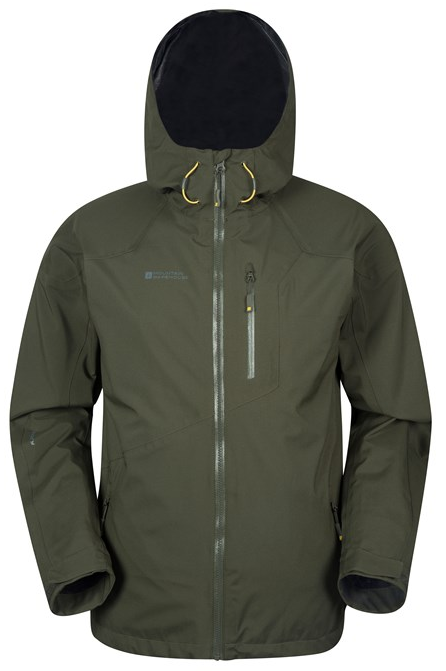Anyone who plans on spending a great deal of time outdoors should invest in a waterproof jacket. Waterproof jackets block out rain and other precipitation, keeping your clothes and skin dry, thereby reducing your odds of catching a cold or facing hypothermia. Some jackets are better suited for certain activities, however, so you should familiarize yourself with the options before you make your purchase.
1.Buy the proper fit. A waterproof jacket should fit snugly without restricting your movement. When trying one on, move around: jump up and down or wave your arms around. Do whatever it takes to guarantee that you have your full range of movement available to you.
2.Pay attention to weight. Lightweight jackets are excellent choices for individuals who do not plan to wear their jackets for extended periods of time or in heavy downpours, but people who plan on spending a day in the rainy outdoors should look for a mid-weight jacket. Heavier jackets typically offer more protection. A jacket that is too heavy might be difficult to move around in, however, making it less than ideal for intense physical activities.
3.Know the difference between waterproof and water-resistant. Most soft shell jackets and windbreakers fall under the water-resistant category. They keep you dry during light showers, mists, and snow, but leave you drenched after a downpour. Hard-shell jackets often have waterproof laminates or coatings that keep larger amounts of moisture out more effectively.
4.Look for the right amount of breathability. A jacket that is waterproof in both directions will keep the rain out, but it will also keep your sweat trapped inside. As such, these jackets are a poor choice for hikers and climbers. These individuals should look for jackets with a special membrane layer that allows small water molecules, in the form of sweat, to pass through, while trapping large raindrops on the outside.
5.Consider jackets with a waterproof coating for an inexpensive alternative.Jackets containing waterproof membranes, also called "laminates," offer the best balance between water-resistance and breathability, but they can be somewhat expensive. Waterproof coatings are just as effective at keeping the rain out, but breathability is often restricted.
6.Only wear non-breathable rainwear during stationary activities. Most coated rainwear offer minimal breathability, but some fully coated fabrics and ponchos offer none. As a result, wearing them during exercise may cause you to overheat. Only wear these jackets for relatively stationary activities, like bird watching or fishing.
7.Invest in a high-quality jacket if you plan to wear it during extended, intense exercise. Cyclists, mountaineers, and trail runners generate a great deal of body heat and sweat, making a breathable jacket essential to avoid discomfort and overheating. They also spend a long time outside, making solid waterproofing equally essential. A cheap, poorly-constructed jacket will do a poor job of providing either.
8.Wear a soft-shell jacket on days with minimal precipitation. Soft-shell jackets are made of tightly woven yarns and have excellent breathability, making them comfortable for intense exercise and casual strolls. They only delay water penetration, however, and do not prevent it, making them a poor choice in heavy precipitation.
9.Buy a snow sport specific jacket to protect yourself against cold weather precipitation. These jackets are designed to keep you warm while shielding you against snow and slush. Look for one if you intend to wear your jacket for cold weather rock climbing, ice skating, skiing, snowboarding, or mountaineering.
Consider Additional Features
Look for a jacket with a hood. Any situation that exposes your torso to water will also expose your head, and hoods may prove more effective at keeping moisture out than umbrellas or hats. Detachable hoods give you the option of removing your hood when you do not need it.
Consider a jacket with draw cords. Draw cords are usually located at the bottom hem, waist, and collar. During intense precipitation or cold, you can draw these openings closed to provide maximum protection. When you need greater freedom of movement, you can loosen your restrictions by loosening the draw cords.
Opt for zipper jackets over pull-over types.Zipper fronts offer greater versatility and allow you to regulate your body temperature more easily.
Add further protection with a storm flap. A storm flap is a strip of fabric that lies behind the front zipper of a jacket. This material prevents rain and wind from seeping in through the zipper.
Look for jackets with zippered vents and armpit zippers. These features add weight to the jacket, but they go a long way in keeping your body temperature regulated. During heavy rains, seal the vents to keep yourself warm and dry. During intense exercise, unzip the vents to cool yourself down and improve your jacket's breathability.
Search for jackets with mesh-lined pockets. Pockets are a convenient feature to have, regardless of their lining. Mesh-lined pockets provide the added convenience of extra ventilation, making it easier for sweat to evaporate away during physical activity.



 What do we change after Covid-19
What do we change after Covid-19